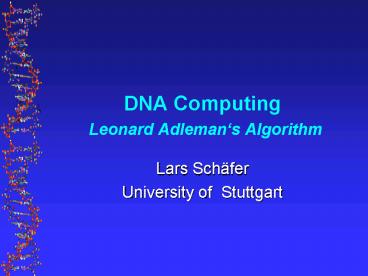DNA Computing Leonard Adlemans Algorithm PowerPoint PPT Presentation
1 / 24
Title: DNA Computing Leonard Adlemans Algorithm
1
DNA Computing Leonard Adlemans Algorithm
- Lars Schäfer
- University of Stuttgart
2
Motivation
- Limited parallelism of electronic computers
- Silicon close to physical limits
- Speed
- Size
- New approaches
- Quantum computing
- Optical computing
- DNA computing
3
DNA Computing
- DNA can perform computations
- Stores information (up to 108 TByte in 1 liter)
- Allows manipulation
- DNA is tiny and "fast"
- New computing paradigm
- Try all possible solutions (parallel)
- Remove wrong solutions
4
Outline
- DNA structure
- Biochemical processes
- Electrophoresis
- Ligation
- Polymerase Chain Reaction (PCR)
- Adlemans algorithm
- Conclusion
5
Outline
- DNA structure
- Biochemical processes
- Electrophoresis
- Ligation
- Polymerase Chain Reaction (PCR)
- Adlemans algorithm
- Conclusion
6
DNA Structure
5
4
1
3
2
7
DNA Structure - Single Strand
- 4 Bases
- Adenine (A)
- Thymine (T)
- Cytidine (C)
- Guanine (G)
- Distinctive ends
- 5 (5-prime) end
- 3 end
- Sequence
- 5-ATCG-3
8
DNA Structure Double Strand
- Annealing
- G lines up with C
- 3 hydrogen bonds
- A lines up with T
- 2 hydrogen bonds
- Watson-Crick complement
- 5-ATCG-3
- 3-TAGC-5
- "Double Helix"
- 2 intertwined strands
9
Outline
- DNA structure
- Biochemical processes
- Electrophoresis
- Ligation
- Polymerase Chain Reaction (PCR)
- Adlemans algorithm
- Conclusion
10
Biochemical Processes - Electrophoresis
- Separation of DNA depending on
- Size
- Electrical charge
- Fill with agarose gel (0.5 5)
- Load slots with samples and ladder
- Apply current
- Identify and extract
11
Biochemical Processes Ligation
- Enzyme T4 DNA ligase
- Anneal
- Overhanging complementary ends (sticky ends)
- Hydrogen bonds
- Ligate
- Covalently bond 3 and 5 ends
12
Biochemical Processes Polymerase Chain Reaction
- Replication of DNA
- Polymerase enzym
- Complementary copy of template strand
- Primer signals starting point
13
Outline
- DNA structure
- Biochemical processes
- Electrophoresis
- Ligation
- Polymerase Chain Reaction (PCR)
- Adlemans algorithm
- Conclusion
14
Directed Hamiltonian Path Problem
4
- Find Path, which
- Starts at vin
- Ends at vout
- Passes every vertex exactly once
- vin0 and vout6
- 0?1 ? 2 ? 3 ? 4 ? 5 ? 6
- NP-Complete
- No polynomial time algorithm known
3
1
6
0
2
5
15
Graph Encoding with DNA
- Vertex i
- Random 20-mer DNA sequences Oi
- Watson-Crick complement Oi
- Edge i ? j
- 3 10-mer of Oi (For i 0 take all of O0)
- 5 10-mer of Oj (For j 6 take all of O6)
- Preserves edge orientation
16
Adlemans Algorithm
- Try all possible solutions, then remove wrong
solutions - Generate random paths through the graph
- Keep only those paths that begin with vin and end
with vout - Keep only those paths that enter exactly n
vertices - Keep only those paths that enter all of the
vertices at least once
17
Step 1
- Generate random paths
- For each vertex i (except 0 and 6)
- 50 pmol of Oi
- For each edge i ? j
- 50 pmol of Oi ? j
- Ligation of Oi ? j with Oi as "connectors"
18
Step 2
- Amplify paths with vin 0 and vout 6
- Polymerase Chain Reaction
- Number of other paths is negligible
19
Step 3
- Keep only paths that enter exactly n vertices
- Agarose gel electrophoresis
- Extract 140 base-pair (bp) band
20
Step 4
- Keep only paths that enter all vertices
- Produce single stranded DNA
- Affinity separate
- Conjugate Oi to metal beads
- Oi anneals to path containing Oi
- Magnetic field retains Oi
- Drop other paths
- Repeat for all Oi
- Electrophorese
- If 140 base-pair band is present
- Hamiltonian path exists
21
Algorithm Summary
- First molecular computation
- Brute force
- Massively parallel
- Complexity
- Linear complexity in bio steps
- Exponential complexity in DNA strands
- 70 vertices require 1025 kg DNA
- Attempt to repeat experiment failed
- Ambiguous results
- Protocols error prone
- Sensitive to impurities
22
Conclusion
- Still basic research (only 8 years)
- Better protocols
- Better DNA algorithms
- Feasibility of DNA computing
- Advantages
- Extremely high information density
- Massive parallelism
23
Thank You!
24
DNA Structure

